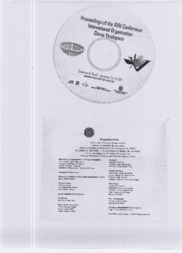Evaluation of early diagnosis of citrus greening using laser-induced fluorescence spectroscopy.
Evaluation of early diagnosis of citrus greening using laser-induced fluorescence spectroscopy.
Autoria: CARDINALI, M. C. B.; VENÂNCIO, A. L.; KUBOTA, T. M. K.; MILORI, D. M. B. P.; FERREIRA, E. J.; MARTINS, P. K.; FREITAS-ASTÚA, J.
Resumo: Greening (HLB) is the most devastating disease that citrus plants face nowadays. The state of Sao Paulo, the largest producer of citrus in Brazil, has increasing incidences of this disease, which has no cure and makes trees unproductive over time. The strategy adopted by producers consists in elimination of symptomatic trees and spraying for vector control. However, this control is not effective because the plants have a long asymptomatic phase. This fact makes them invisible sources of inoculum. This study proposes the use of Laser-Induced Fluorescence Spectroscopy (LIFS) for early diagnosis of HLB in citrus plants. Leaves from healthy and inoculated plants with Candidatus Liberibacter asiaticus were assessed. Artificial Neural Network was used as chemometric tool for classifying spectra. Real-Time Polymerase Chain Reaction (RT-qPCR) measurements were performed to detect the presence of the bacteria. Based on the LIFS and RT-qPCR results, it is possible to determine that the chemical changes and the bacteria are unevenly distributed in the tree, and the accuracy of diagnosis increases with the number of collected leaves. Nevertheless, our results show that LIFS has great potential for early Greening diagnosis. In the third month after inoculation, around four months before the appearance of symptoms, 83% success rate was achieved. In the seventh month, LIFS has above 85% of success rate with high correlation with the RT-qPCR.
Ano de publicação: 2010
Tipo de publicação: Resumo em anais e proceedings
Unidade: Embrapa Instrumentação
Palavras-chave: Bactéria, Candidatus Liberibacter asiaticus, Doença de Planta, Evento, Fruta Cítrica, Greening, Plant disease
Observações
1 - Por padrão são exibidas publicações dos últimos 20 anos. Para encontrar publicações mais antigas, configure o filtro ano de publicação, colocando o ano a partir do qual você deseja encontrar publicações. O filtro está na coluna da esquerda na busca acima.
2 - Para ler algumas publicações da Embrapa (apenas as que estão em formato ePub), é necessário ter, no celular ou computador, um desses softwares gratuitos. Sistemas Android: Google Play Livros; IOS: iBooks; Windows e Linux: software Calibre.
Acesse outras publicações
Acesse a Base de Dados da Pesquisa Agropecuária (BDPA) para consultar o acervo completo das bibliotecas da Embrapa.

